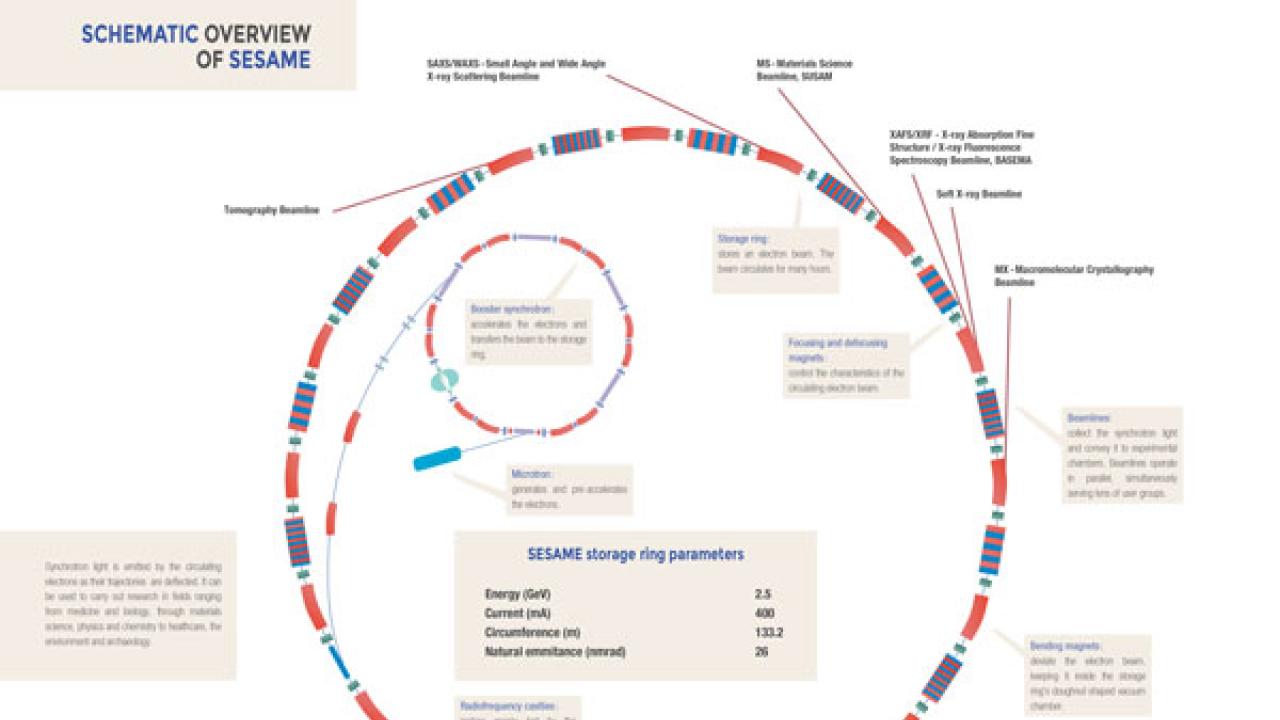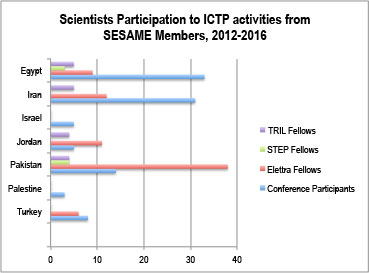
Building scientific capacity in the developing world is one of ICTP's main missions, and so it is fitting that ICTP has long been involved in the creation of a synchrotron light source research facility in the Middle East, the first in that region. ICTP's founder Abdus Salam proposed the idea for such a regional scientific center back in 1983, hoping that scientific cooperation could pave the way for future peace, growth, and collaboration between Middle Eastern countries. Now his hopes are coming to fruition: the Synchrotron-Light for Experimental Science and Applications in the Middle East, known as SESAME, will be officially inaugurated on 16 May 2017.
Photos from the ceremony and surrounding events can be found on ICTP's Flickr.
SESAME is run by an independent intergovernmental organization, a coalition of scientists from eight governments, some of which have long histories of not talking to each other. Representatives of members Cyprus, Turkey, Israel, Iran, Pakistan, Egypt, Jordan, and the Palestinian Authority have committed their support via funding and other resources since the project was launched officially in 1999. Jordan, as the only country that had diplomatic relations with all members at that time, contributed the facility site in Allan. This sort of cross-border scientific endeavor is partially modeled on CERN, the European Organization for Nuclear Research, which was founded after World War II to foster cooperation between countries and rebuild scientific networks. Like CERN, SESAME aims to use science as a common language for its culturally diverse coalition.
In a synchrotron, bunches of charged particles—electrons—circulate at nearly the speed of light inside a long, ring-shaped tube under vacuum. As magnets surrounding the tube bend their trajectories, the electrons emit ‘synchrotron light’, with wavelengths that range from the infrared part of the spectrum to X-rays. The emitted light is collected by different ‘beamlines’ (optical systems) connected to the ring; thus, many experiments can be run simultaneously. There are currently over 40 synchrotrons worldwide, with several more in the planning stages. Physicists, materials scientists, biologists, medical researchers, and archeologists are only a few of the types of scientists who apply for time on synchrotron beamlines for their experiments, so the user community of SESAME will be very broad.
Scientists from other countries with synchrotrons have observer status on the SESAME Council to contribute expertise and advice, as do several organizations, ICTP included. ICTP physicist and former director of the Office of External Activities Joe Niemela has been ICTP's representative to SESAME for many years, as well as the Centre’s liaison with the synchrotron based in Trieste, Elettra. ICTP and Elettra have been supporting the development of SESAME by offering many training opportunities in synchrotron-related topics. Since 2012, nine workshops on synchrotron-related topics have been sponsored and organized by ICTP, with 20% of attendees coming from SESAME members. In addition, thanks to ICTP's Sandwich Training Educational Program (STEP) and its Training and Research in Italian Laboratories (TRIL) program, synchrotron scientists from SESAME members have had access to Elettra’s beamlines, providing them with valuable hands-on training. In total, over 200 scientists have benefited from ICTP-sponsored training activities related to SESAME, and there are no plans to slow down. "We're very much involved in developing the community of scientists that could do great science at SESAME," says Niemela, whose former position on the SESAME Training Committee has been passed on to ICTP physicist Nadia Binggeli.
SESAME will start with two beamlines: the x-ray absorption/fluorescence spectroscopy beamline and the infrared spectromicroscopy beamline. These two beamlines were built first to cater to some of the scientific needs of the region; the x-ray absorption beamline will be particularly useful for environmental and materials science, and the infrared beamline will have applications in biology, medicine, as well as materials science. "The facility has the space and capacity to have many more beamlines," Binggeli explains, "but the goal is to have state of the art technology, to both serve the region and attract scientists from all over the world."
The quality of the technology is important. Niemela and his colleagues on the SESAME council have worked for years to counteract an early misconception about SESAME: the original donated equipment, dismantled from a German synchrotron called BESSY 1, would have made SESAME a second generation synchrotron and therefore not competitive for scientists seeking to do high-level science. But now, almost all of the BESSY I components have been replaced and upgraded. With these refinements, SESAME will be a modern third generation light source, hosting top-notch synchrotron technology, comparable to other synchrotron facilities worldwide. "SESAME will belong to the region," Niemela said, "but anyone can apply for beam time. The goal is to have SESAME be known as a home for high-quality science done with first-rate equipment."
Between the rocky politics of the region, securing funding commitments, training scientists, and developing and building equipment, SESAME has faced grand challenges. "To get to this point is a great accomplishment," says Binggeli. "It's going to be a very interesting light source for science and peace." ICTP congratulates everyone involved in SESAME, and looks forward to the innovative science the facility will foster.
---- Kelsey Calhoun
















